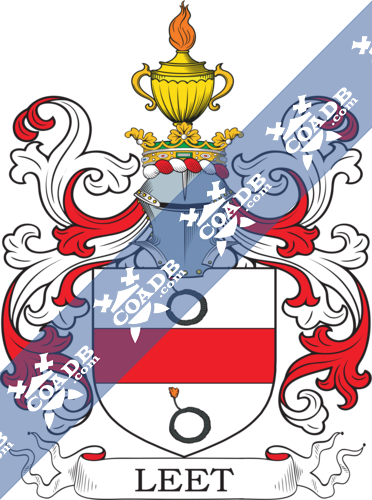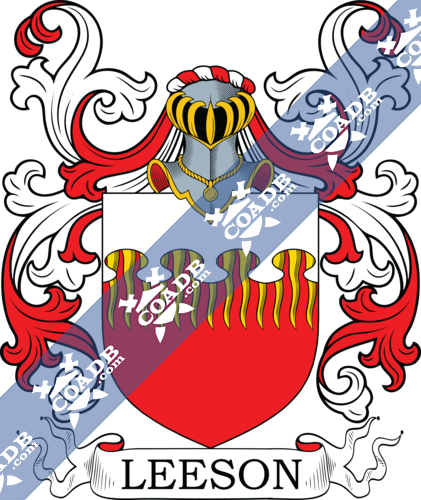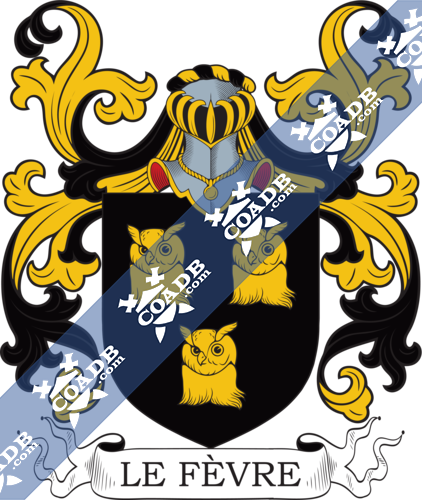Leet Family Crest, Coat of Arms and Name History

Leet Coat of Arms Gallery
Don’t know which Coat of Arms is yours?
We can do a genealogical research. Find out the exact history of your family!
Learn MoreLeet Origin:
England
Origins of Leet:
This unique surname is of Anglo-Saxon origin, and is either a geographical name from a home by a lake or water area. It acquired from the Olde English pre 7th Century “(ge)laet”, which means passage, canal, or a geographical name from any of the little places named with this word, like Leat in Devonshire, or The Leete in Essex. Geographical surnames were created in ancient times, they provided easily identifiable outstanding names in the small towns of the Middle Ages. Geographical names were frequently given to local landholders, and the kings of the palace, and especially as a source of recognition to those who departed from their mother town to settle to any other place. In the year 1330, one John atte Lete was noted in “Place Names of Devonshire”, and in August in the year 1594, Joyce Leete and Mark Newcome married at St. Botolph’s, Colchester, Essex. In the new era, the name has six spelling variations like Leat(e), Leet(e), Leatt and Leates. A Royal Symbol gave to the Leete family of Bury St. Edmunds, Suffolk, is a silver shield.
Variations:
More common variations are: Leete, Leeto, Leety, Leeta, Leett, Leeti, Leyet, le Et, Leedt, Lewwt.
England:
The surname Leet first appeared in Cambridge where there is some argument over the origin of the name. One reference shows the name is a location name meaning “a meeting of turning point” as in “court-leet and borough-leet,” while another shows the name was an introduction name “the son of Lettice” (Latin laetitia, gladness) from the nickname Lete. Lettice was a very famous girl’s name in its day but was less by the late 1800s. Inattentive of the origin, the first documents of the name were in Cambridge where Letia (no surname) was recorded there in the Hundredorum Rolls of 1273. The same rolls list Nicolas filius Lete in Bedfordshire, Walter Lete in Suffolk and Roge Lete in Oxfordshire.
The very first recording spelling of the family was shown to be that of William Lete, dated about 1279, in the “Assize Court Rolls of of Somerset.” It was during the time of King Edward I, who was known to be the “The Hammer of the Scots,” dated 1272-1307. The origin of surnames during this period became a necessity with the introduction of personal taxation. It came to be known as Poll Tax in England. Surnames all over the country began to develop, with unique and shocking spelling varietions of the original one.
Ireland:
Many of the people with surname Leet had moved to Ireland during the 17th century.
United States of America:
Some of the people with the surname Leet who arrived in the United States in the 17th century included Mr. Leet, who arrived in Jamestown, Va in the year 1624. William Leet, who arrived in New England in the year 1637. Samuel Leet, who landed in Maryland in 1664. Andrew Leet, who arrived in New England in the year 1678.
Australia:
Some of the individuals with the surname Leet who landed in Australia in the 19th century included Mary Ann Leet arrived in Adelaide, Australia aboard the ship “Constance” in the year 1848.
New-Zealand:
Some of the population with the surname Leet who arrived in New Zealand in the 19th century included George Leet at the age of 29, Jane Leet, John Leet, Mary Leet and Jane Leet, all arrived in Wellington, New Zealand aboard the ship “Hurunui” in the same year 1877.
Here is the population distribution of the last name Leet: United States 2,370; Canada 213; Australia 199; Estonia 169; England 167; Russia 62; Singapore 41; Sweden 29; New Zealand 24; Nethenands 13.
Notable People:
Isaac Leet (1801–1844), was an American political leader.
Mildred Robbins Leet (1922–2011), was an American businessman.
William Knox-Leet (1833–1898), was an Irish Victoria Cross recipient.
Blazons & Genealogy Notes
1) (Eversden and Kingston, co. Cambridge, and Southoe, co. Huntingdon). Ar. a fesse gu. betw. two rolls of matches sa. kindled ppr. Crest—On a ducal coronet an antique lamp or, fire ppr.
2) (Bury St. Edmunds, co. Suffolk). Same Arms, a martlet for diff. Crest—A demi bull issuing gu. gorged with a chaplet of laurel vert.








